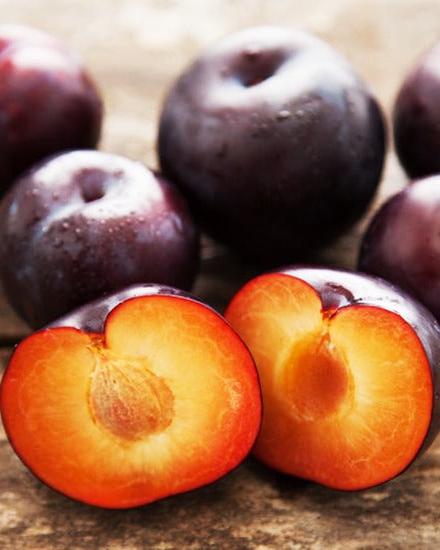Plumcot, Spring Satin, Bare Root
Sweet-Tart Early Plum-Apricot Hybrid
Plumcot, Spring Satin, Bare Root - Bare Root / 4-5' / Standard Halford Rootstock is backordered and will ship as soon as it is back in stock.
Couldn't load pickup availability
Delivery and Shipping
Delivery and Shipping
Make sure to thoroughly review our entire "Shipping, Returns, Refunds, and Our Guarantee" page for all relevant details about ordering from our store.
Making a purchase from our store constitutes an agreement to all the conditions outlined in those policies.
We appreciate your support and look forward to being your favorite plant provider!
Plumcot, Spring Satin (Prunus salicina × armeniaca 'Spring Satin')
Spring Satin is a standout interspecific hybrid—half plum, half apricot—that combines the best traits of both. Developed at the University of Arkansas, this vigorous and productive tree yields deep purple-skinned fruit with firm, juicy, apricot-colored flesh. Sweet-tart and aromatic, Spring Satin ripens early in the season and brings complex flavor to the fresh fruit table. It’s especially well-suited for Southern growers and fits beautifully into diversified orchards and food forest designs where early-season fruit and disease resistance are valued.
Key Characteristics
-
Exceptional early-season fruit with complex flavor
Spring Satin produces medium to large fruits with dark purple skin and golden-orange flesh. The taste is a perfect balance of plum sweetness and apricot tang, making it excellent for fresh eating, jam, and desserts. It’s one of the first stone fruits to ripen, helping to kick off the harvest season. -
Reliable production and disease resistance in humid climates
Bred for Southern conditions, Spring Satin is resistant to bacterial spot and has moderate resistance to brown rot. This makes it a great low-spray or organic option for growers in regions with hot, humid summers. -
Hybrid vigor and excellent growth habit
As a plum-apricot cross, Spring Satin shows vigorous growth and early bearing. It forms a well-shaped tree suitable for small orchards, food forests, or edible landscapes where quick establishment and early yields are desired. -
Requires a compatible pollination partner
Spring Satin is not self-fertile and requires another Japanese-type plum nearby for fruit set. Methley and AU Rosa are excellent pollination partners. Planting multiple Japanese-type plums improves yield and supports beneficial insect activity in orchard systems. -
Great choice for permaculture and food forest systems
Spring Satin fits well into the mid-canopy layer of food forests or sunny edges in diversified orchards. Its early bloom and fruiting schedule provide early-season nectar for pollinators and fresh food when few other fruits are ripe.
Product Details
- Sun requirements: Full sun
- Soil requirements: Medium, well-drained
- Bloom time: Early to mid-season
- Bloom color: White
- Fruit qualities: Dark purple skin, apricot-colored flesh, firm, juicy, sweet-tart flavor
- Fruit uses: Fresh eating, preserves, desserts
- Fruit ripening month: Early June (may vary by region)
- Required chill hours: ~500–600
- Pollination requirements: Requires Japanese-type plum pollinator (e.g., Methley, AU Rosa)
- USDA Hardiness Zones: 5–9
Spring Satin offers rich flavor and early harvests with minimal disease worries—an excellent addition to Southern orchards and permaculture plantings aiming for diversity, resilience, and early yield.
-
Sun RequirementsFull Sun
-
Soil RequirementsMedium, Medium-Dry, Medium-Wet
-
Bloom ColorWhite
-
Bloom TimeMarch, April
-
USDA Hardiness ZonesZone 5, Zone 6, Zone 7, Zone 8, Zone 9+
-
Chill Hours400
Payment & Security
Payment methods
Your payment information is processed securely. We do not store credit card details nor have access to your credit card information.




